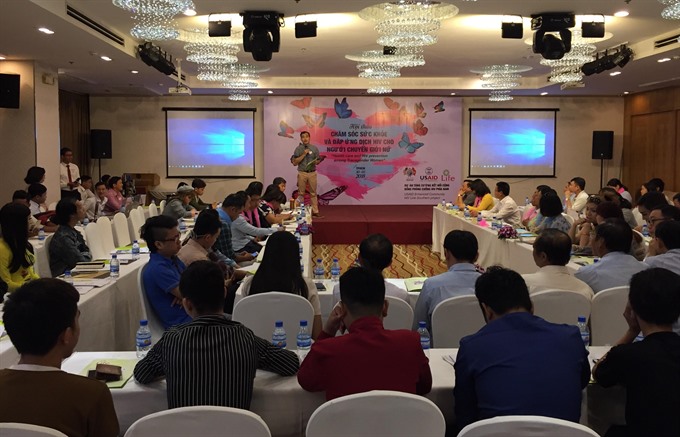 Society
Society
.jpg)
HCM City needs to develop specific healthcare policies and guidelines for transgender women as HIV prevalence among this group is estimated to be about 19 per cent worldwide, according to Dr Hoàng Đình Cảnh, deputy director of the Việt Nam Authority of HIV/AIDS Control.
 |
| A workshop discusses healthcare and HIV prevention for transgender women in HCM City. — VNS Photo |
HCM CITY — HCM City needs to develop specific healthcare policies and guidelines for transgender women as HIV prevalence among this group is estimated to be about 19 per cent worldwide, according to Dr Hoàng Đình Cảnh, deputy director of the Việt Nam Authority of HIV/AIDS Control.
The risk of contracting HIV is 49 times higher for transgender women than in the general population, he said.
Speaking at a workshop on healthcare and HIV prevention for transgender women on May 30 in HCM City, Cảnh said that more research and surveys should be conducted to gather information and evaluate the effectiveness of solutions.
He called on the Government, NGOs, the community and transgender people to help reduce the rate of HIV prevalence among transgender women, and achieving the UN’s 90-90-90 Goals in HIV/AIDS prevention and control by 2020.
He praised the work of the HCM City University of Medicine and Pharmacy, which produced a research report in collaboration with the Centre for Promotion Quality of Life (LIFE) on risk factors leading to HIV infection among transgender woman in HCM City.
Đỗ Văn Dũng, vice rector of the university and head of the research group, said the cross-sectional study was conducted among 456 transgender women in HCM City from February to May this year.
The study used respondent-driven sampling (RDS) and computer-assisted personal interviews (CAPI).
It found that 77 of 456 transgender women were living with HIV, accounting for 16.5 per cent of the total interviewed.
About 67.3 per cent of the people living with HIV were receiving anti-retroviral (ARV) therapy. However, most transgender women said they had not used pre-exposure prophylaxis (PrEP) drugs.
The survey found that more than 50 per cent of the respondents had previously contracted a sexually transmitted disease (STD).
More than 40 per cent of those surveyed said they have regular sex with male partners, and 55 per cent said they were not regularly using condoms within 30 days prior to the study.
About 25 per cent of people said they received payment for sex with men who were not their regular sex partners, 53 per cent of them not using condoms regularly, the survey found.
Factors that contribute to HIV transmission among transgender women consist of non-use of condoms; drinking more than four units of alcohol; use of amphetamine-type stimulants (ATS) before sex; and incidents related to gender inequality and social discrimination.
“Severe social stigma and discrimination may create barriers to accessing HIV testing and treatment services,” one transgender woman told the researchers.
The study recommended that untreated HIV-infected people should have better access to treatment and healthcare services related to PrEP and STDs.
Developing effective strategies and enhancing interventions are also needed to raise awareness in the transgender community of the proper use of condoms, alcohol, and ATS.
“Programmes on preventing discrimination against transgender women living with HIV should promote gender equality in healthcare services,” Dũng said.
The workshop was organised by the LIFE, which is part of a project titled “Strengthening Community Connections for HIV/AIDS Prevention and Control in Southern Provinces” (C-Link) funded by the US Agency of International Development (USAID). — VNS
.jpg)








